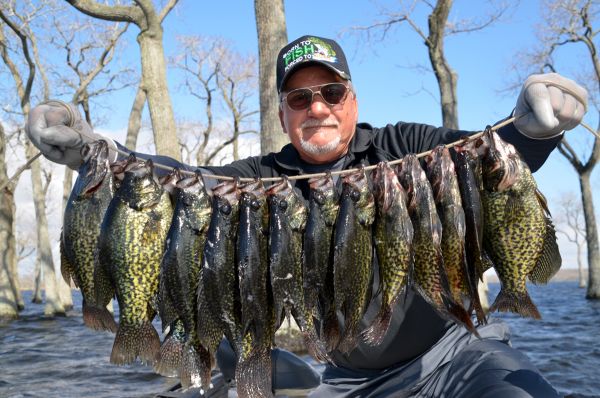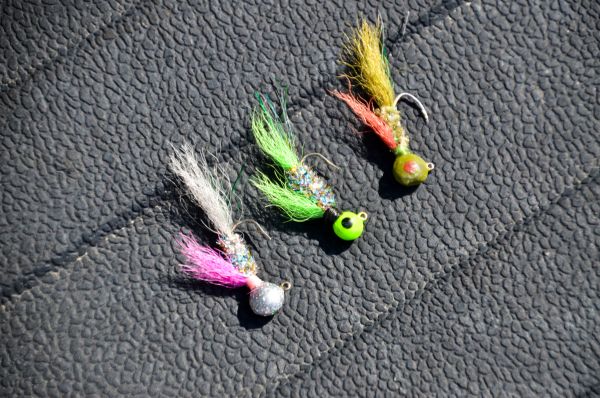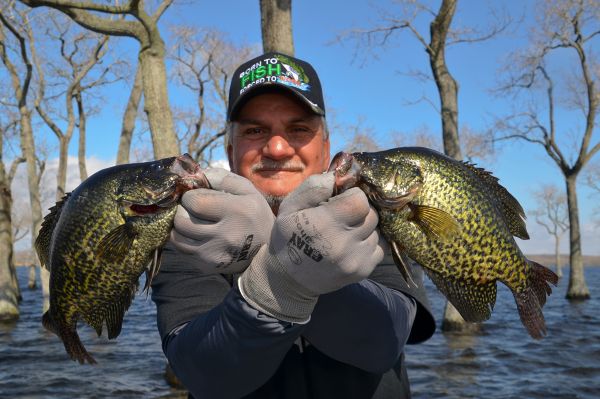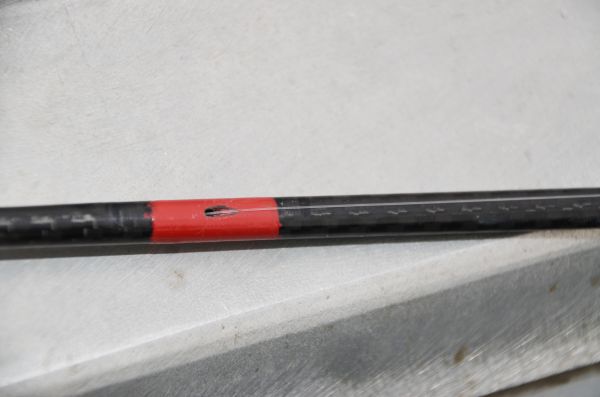 Miller’s Lake is a black crappie mecca, and this Duson angler has it all figured out. Use his tips to fill limits of the delectable fish.
Miller’s Lake is a black crappie mecca, and this Duson angler has it all figured out. Use his tips to fill limits of the delectable fish.
“It looks like it going to be perfect tomorrow,” the Cajun-accented voice on the telephone murmured conspiratorially. “It’s supposed to be a high of 55 degrees, a little bit of rain in the morning and then it clears up till late that night when it rains heavily with that front. The barometer will be falling.
“Some of the big females I caught yesterday had eggs running out of them. Then it’s supposed to be cold all next week.”
The voice belonged to Murphy Royer. I had fished with Royer before, and I knew he was one of the best.
I was raring to go.
We left Royer’s home in Duson well before daylight. It was about an hour’s drive to our destination, Miller’s Lake near Ville Platte.
He described the unusual lake to me while we were on the road.
“The lake was created to serve as a reservoir for surrounding rice farms,” he said. “In the summer, when water demands by farmers are high, lake levels will recede to just what’s in the lake’s channels.
“And there’s not much water in those. It’s unbelievable that the fish can survive.”
They do more than survive; they thrive.
The lake, he said, is renowned for black crappie, but it also produces lots of largemouth bass and bream.
By his estimate, a third of the lake is densely overgrown with buttonwood bushes.
“It’s hard fishing those,” Royer grunted. “You have to stand up and fish over the tops of the bushes.”
But most of his fishing is done at the bases of gnarly tupelo gum trees set in 3 to 3 ½ feet of water and strewn across the center of the lake.
The water in the buttonwoods is only about a foot deep.
Calling the lake shallow is an understatement.
The lake also holds 70-something duck blinds, but they yield few fish.
We arrived at the lake’s single private boat launch well before daylight. Two other boatloads of anglers were already there, with their boats launched but tied up. Royer joined them after paying the $5 launch fee.
No one can leave the launch until the caretaker, who lives almost next to it, gives the thumbs up.
While they wait, the men compared notes and expectations about what this year’s crappie season would bring.
One thing they all agreed on was the lake’s spectacular fishing.
Royer claimed the lake has “easily” produced his biggest fish on a consistent basis. One of the others opined that the huge number of blackbirds roosting in the lake’s buttonwoods was responsible for the good fishing.
“The fish eat the poop; they really do,” he said.
The spawning male crappies they were here for, they gushed, are so colorful they are almost black.
The major drawback, according to Royer, is that some years the hot spawning bite only lasted seven to 10 days.
He did add that sometimes the crappie run was fairly strong in the summer, too, before levels are drawn down for flooding rice fields.
On cue from the caretaker, all three boats roared off toward the center of the lake. Daylight revealed millions of redwing blackbirds tolling back and forth across their roosts in the buttonwoods.
The air was literally black with the birds. But within 20 minutes they are all gone — all of them. It was hard to imagine what food source surrounding the lake they went to raid.
As Royer predicted, the sky was heavily overcast and the air pregnant with rain. Even with the poor light, however, it was easy to see that the lake’s water was crystal clear, although it was fertile enough to produce bumper crops of fish.
During the summer and early fall, the lake is overgrown with the giant lily pad-like leaves of water lotus plants. Now, in February, only stem stubs and leaf fragments remained, although a few newly developing leaves were visible just beneath the water’s surface.
Royer quickly unlimbered one of his prerigged 10-foot jig poles.
From the get-go, Royer fished aggressively, almost lashing the water with his line like whip. None of this gentle underhand swing and drop stuff.
It was barely light enough to see when Royer caught his first two beautiful, greenish-black crappies. The clear water of the lake accentuated the dark spawning colors of the males.
 Royer admitted to often tight-lining in other places, but here he typically fishes with a cork on his line.
Royer admitted to often tight-lining in other places, but here he typically fishes with a cork on his line.
His reasoning is simple: Without a cork, a fisherman is limited mostly to fishing his rod’s length away from his target spot, and with a cork he can fish the rod length plus the line length away from the target.
In the clear and extremely shallow waters of Miller’s Lake, his strategy was to keep his boat as far away as possible from the bases of the tupelo gum trees that he was targeting.
After throwing his cork as near to a tree as possible, he alternately twitched, pulled, bumped and paused the bait.
“Every day they want something different,” Royer said softly.
He used his trolling motor to circle each tree or cluster of trees like a vulture. He probed all sides and each angle on each tree.
Royer was a model of fishing efficiency. He kept a hand tally counter at his feet to keep track of his catch, clicking the counter every time he bent over to put a fish in the box.
His custom-built aluminum boat has two recessed wells to hold ice chests: one on the bow deck and one on the rear deck. His short pedestal seat was mounted immediately in front of the bow ice chest; he can drop each fish in the front ice chest without getting up.
The trolling motor was at his left hand’s fingertips. He could easily reach his homemade landing net — again without getting up — with his right hand.
Another pedestal seat mount for a second angler was located on the deck on the opposite side of the ice chest next to Royer.
The name of the game this morning was “move, move, move.” Royer caught fish regularly, but never more than two in one spot.
He bounced from tree to tree, relentlessly pounding their bases, fearing the bite might be nearing its end.
At 10:30 a.m., the sun broke through the clouds. The bite got raggedy and then quit.
“It was an OK morning,” Royer grimaced. “Sometimes it’s a lot better.”
He could have fooled me.
About Miller’s Lake
The 3,200-acre Miller’s Lake in Avoyelles Parish is unusual in that it is entirely private but open to public fishing.
Gene Bullard of Ville Platte, the secretary-treasurer of the Miller’s Lake Hunting Club, is rich with the lore of the lake.
The footprint of the present lake was once a bunch of little sloughs and bayous known in Cajun French as a “platin,” because the area was so flat, According to Bullard.
The spot was drained by Bayou Nezpique, named after the local Indian tribe that tattooed their noses.
Gus Miller, a rice farmer who was born and raised between Mamou and Ville Platte, bought about 5,000 acres in the area and drained the higher portions of his purchase into lower areas.
Then in 1927, he built levees to hold the water.
Each year, more dirt was added to the levees, and the lake became larger. In 1952, the family applied through the National Soil Conservation Act to build the present high levees.
The lake was always used for rice field irrigation, but early on Gus Miller formed the Miller’s Lake Hunting Club, the same club that exists today and the one Bullard has been a member of for 63 years.
The club has 100 members, 35 or 40 of which are family members.
The northeastern side of the lake is reserved for family members. And the lake is closed to public fishing during duck season.
According to Mike Perron, the lake caretaker, the use of trotlines, jug lines and yo-yos is prohibited to the public.
During open fishing season, Perron makes the call about what time each morning anglers can leave the dock. All boats must be off the water before sunset.
Bullard said Miller’s Lake is known for big fish. The largest crappie he knows of coming from the lake is 4 pounds. Bluegills are commonly “bigger than your hand,” and redears (aka chinquapin) will run up to 2 pounds.
He calls the lake’s bass fishing “terrific.” The lake record is a 15-pound, 3-ounce hawg.
Bullard maintains that the annual summer draining cycle that pulls the lake down to half its full size creates a drawdown effect.
“It happens every year, and as a result the lake is very fertile.”
Top crappie-fishing gear
You will never find a commercially produced rod-and-reel combo or rubber tube jig in Murphy Royer’s Boat. This man is particular about his tackle, and either makes it or modifies store-bought stuff a lot.
He moved from B’n’M Bucks to Hi-Tech Panfish Special to building his own from Matrix AMF 907 Matrix graphite rod blanks sold by Mudhole Rod Building and Tackle Crafting.
He adds a 9-inch handle with a reel seat (also from Mudhole) to the butt end of each rod.
A Slater’s Pole Reel, made by Slater’s Jigs in Indianola, Miss., is mounted in the reel seat.
Everything else on the pole is modified.
Beginning with line placement, he doesn’t like his line on the outside of the pole, so at exactly 6 feet, 9 inches from the rod tip he drills a hole through the rod at a sharp angle, with the bit toward the rod tip. He then smoothens the edges of the hole with emery cloth.
He runs the line from the reel into the hole and up the rod and out its tip.
The tip of the rod is of his design, as well. It is a 1/8-inch stainless steel (not aluminum, which quickly develops grooves) pop rivet. He removes the pin from each rivet and mushrooms its tip. Super glue is used to attach the tips to the rods.
Fifteen-pound-test Seaguar fluorocarbon is Royer’s line of choice.
“I like its lack of memory,” he explained. “And when it does get curls, I just step on the jig with my foot and pull hard on the line to straighten it out.”
He makes his own jigs from scratch, although he admits a person can buy hair jigs that will catch fish.

As for tube jigs some fishermen like to use, Royer refuses to touch them.
“I don’t like their movement in the water,” he said.
He grinned broadly when asked about his corks.
“I make those, too,” Royer said. “When I couldn’t find natural jigging corks anymore, I tried synthetics but they broke too easily.”
So he bought a miniature belt sander and began shaping his own fishing corks from wine bottle corks. As for his source of wine bottle corks, he said it’s pretty easy to find ready supplies.
“Either drink a lot of wine or know someone who works in a restaurant,” Royer mugged.
He finishes each cork by brushing it with vinyl paint purchased from tackle supply companies.
Royer has begun selling most of his equipment, including finished, hand-made rod-and-reel rigs called “Jig Master by Murphy.”
Don’t look on the Internet for them, though: You will have to call (337-873-4443) to place your order. They are $160, ready-to-fish.
He even sells his hand-made natural corks for a buck apiece.
As for his jigs, well, they’re pretty much for his personal use only.
“I don’t sell them,” Royer said. “They are too much work and most people don’t want to pay the price.”
He relented after some more discussion, admitting that he sells a few to friends at $5 each.
Crappie assassins are made, not born
“I fish four days a week, sometimes five,” Murphy Royer said. “Monday and Tuesday, I fish. Wednesday I clean fish and do chores. Thursday and Friday, I fish, and Saturday I clean fish and do chores.
“But when my grandson Ayden Royer is in town, I will fish on weekend days, too.”
The 65-year-old has been fishing that pace for three years.
“I love it so much. It’s just a passion — it’s a challenge,” Royer said. “Unless you get on a pattern, it’s different every time.”
 While Royer fished some for crappies as a youngster, he became serious in 1975 when he began fishing with brother-in-law Chester Trahan.
While Royer fished some for crappies as a youngster, he became serious in 1975 when he began fishing with brother-in-law Chester Trahan.
“He was good at it,” Royer said. “He learned from his parents. Every weekend we fished out of his boat for 1 ½ years. Then I got my own boat and started fishing alone a lot.
“I averaged fishing every other weekend because I had to work a lot of weekends,” Royer said. “That’s why I couldn’t wait to retire — so I could fish 24/7.”
He started tying his own jigs in 1989. Before that he used Slater Jigs, and before that he used live shiners.
“Shiners die on you. You have to rebait too much,” Royer groaned. “If you can use one jig to catch 300 fish, why use shiners?
“I did that once on Saline Lake. The jig was beat-up when I was done, but it lasted.”
Royer fishes most frequently in Lake Henderson and the Atchafalaya Basin. He also fishes often in Miller’s Lake, Spring Bayou, Saline-Larto, Black Lake-Clear Lake, French Fork and Old River.
He also has a long list of “once-in-a-while lakes.”
He used to be a regular tournament fisherman and admitted to loving it. But he gave it up because of pre-fishing.
“I can’t fish a tournament without pre-fishing,” Royer said.
He mostly fishes solo.
“I love being on the water alone,” Royer said. “I’m not unfriendly— just few people can fish as often as I do.
“The way my boat is set up, it’s just as easy to position it for fishing with two people as one.”
On non-fishing days, Royer often hangs out at Superior Repair Services, a Lafayette trolling motor repair shop. He cooks there (he’s a Cajun, yeah) once a month, and lots of fishermen come by to eat.
Royer has it bad.
“I even dream about catching sac-a-lait,” he admitted with a guilty smirk. “I missed one at Black Lake; it was right there at the boat, and the nut holding the reel spool came loose and the line started backing off. I tried grabbing the line, but it had already spit the hook. It was over 3 pounds. I dreamed about that for a long time; it would have been my first 3-pounder.
“Even when I first started fishing, I would dream about that cork going under.”
Royer’s record-book crappie
 Murphy Royer has been fishing for big crappie a long time, but he was beginning to think he would never catch a record book fish.
Murphy Royer has been fishing for big crappie a long time, but he was beginning to think he would never catch a record book fish.
Admittedly, both white and black crappie categories are competitive categories, but still….
Then lightning struck: On Nov. 15, Royer was fishing in Henderson Lake near his home when a 3.055-pound black crappie inhaled his hand-tied jig.
“I was shocked. I kissed it,” the angler admitted. “I knew it was a 3-pounder. I’ve been fishing 40 years and hoped to catch a 3-pounder before I died.”
He knew it would take a 3-pound fish to make the books, and it did. Royer’s beast lodged in 10th place on the all-time Louisiana Fishing Records.
It was one of 44 crappies he and his fishing partner caught that day.
“I was fishing a cypress tree that I had been catching fish from” he explained. “I dropped my jig and got several little pecks. I thought it was a goggle-eye. That happened three days in a row in the exact same spot.
“On the last day, I set the hook on a peck and had the fish. He didn’t fight at all — just came right up. It felt like dead weight. At first I thought it might be a carp. They do that sometimes. I’ve caught almost everything on a jig.
Then I saw it was a crappie.
“When my partner netted the fish for me, the hook just fell out of its mouth. It didn’t even flop,” Royer said. “It was like it was on its last legs — the way it barely pecked the hook and the way it fought. It makes you wonder.”
Louisiana’s state fish records are maintained by the Louisiana Outdoor Writers Association, and may be viewed on their website.
You can see how Murphy Royer pours his own jigheads, as well as tying the jigs here: How to tie your own crappie jigs
